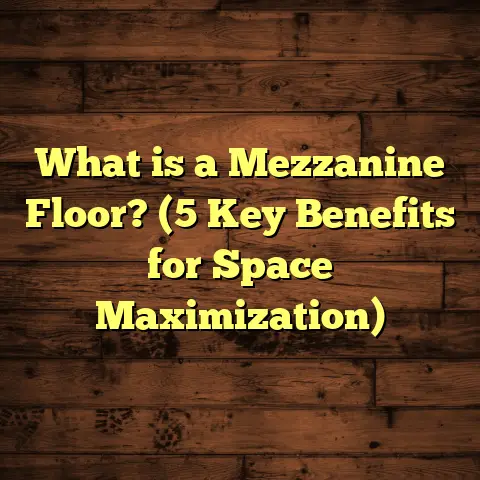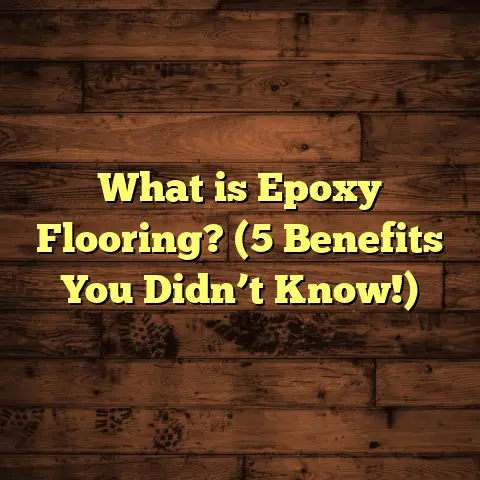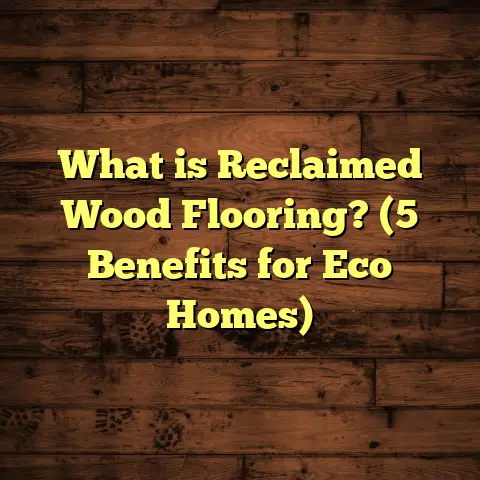What is the Average Cost to Install Flooring? (5 Key Factors Revealed)
What Is the Average Cost to Install Flooring?
Have you ever walked into a room and suddenly felt like the floors just don’t match your style or mood anymore? Maybe you’re tired of the stains on the carpet or the cracked tiles making you trip. If you’ve been thinking about upgrading your floors, you might be wondering how much it will cost to install new flooring. Honestly, I’ve been there too—standing in my own house, trying to figure out what’s reasonable to pay without breaking the bank or ending up with regrets.
You might feel a little anxious because flooring installation can get expensive fast if you don’t know what to watch out for. But don’t worry. Let me share with you everything I’ve learned from years of hands-on experience, managing projects from tiny bathrooms to sprawling living rooms. I’m going to walk you through the average costs, the surprises that can come up, and how you can make smart choices while staying within your budget.
Here’s a quick heads-up: if you don’t get this right, your flooring project can easily blow your budget or take way longer than expected. So let’s get into it and make sure you’re set up for success.
How Flooring Costs Break Down: My Experience Unpacked
When I first started getting serious about flooring projects, I quickly realized that the “average cost” people talk about is just a starting point. The actual price depends on a handful of key factors that I always ask my clients to consider:
- Type of Flooring Material
- Labor and Installation Complexity
- Location and Local Market Rates
- Room Size and Shape
- Subfloor Preparation and Removal
I’ll go through each one in detail and share stories, tips, and numbers that will help you create a realistic budget—whether you’re a DIY enthusiast or planning to hire a pro.
1. Type of Flooring Material: More Than Just Looks
The type of flooring material you pick is probably the most obvious cost driver. But what surprised me was just how much the price per square foot can vary—and why it’s not just about picking what looks good.
Let me tell you about my first major flooring project. I was working with a client who wanted hardwood floors throughout their house. When I quoted them around $12 per square foot for the wood alone, their eyes nearly popped out. They had expected something closer to $5.
Why such a difference? Hardwood isn’t just one thing; there are different species, grades, finishes, and thicknesses that influence price:
- Oak: The most common hardwood, generally affordable at $8-$12 per sq ft.
- Maple: Slightly pricier at $9-$14 per sq ft.
- Exotic woods like Brazilian cherry or teak: Can run $15-$20+ per sq ft.
- Engineered hardwood: Usually a bit cheaper than solid hardwood but varies depending on veneer thickness.
On top of that, hardwood requires proper acclimation time before installation and careful handling, adding to labor time.
Contrast this with laminate flooring. When I did a budget-friendly remodel for a friend’s apartment, laminate was around $3 per sq ft for materials. It looked great and was easy to install as a floating floor without nails or glue—labor was cheaper too.
But laminate has its downsides—less durable against moisture and scratches compared to hardwood.
Vinyl flooring has evolved drastically over the past decade. Luxury vinyl tile (LVT) now mimics wood and stone closely but costs much less—usually between $2 and $7 per sq ft for materials. In wet areas like kitchens and basements, vinyl is often the smartest choice.
For tile lovers, porcelain or ceramic tile offers beauty and durability but expect to pay $5-$10 per sq ft for materials. Plus, grout work and cutting tiles increase labor costs significantly.
And then there’s carpet—often overlooked when thinking about cost but still important. Carpet prices range widely depending on fiber type (nylon, polyester), density, and brand—from $3 to $7 per sq ft for materials.
What I Learned About Material Costs
Material costs don’t tell the whole story:
- Always factor in delivery fees.
- Don’t forget underlayment or padding costs (especially under hardwood or laminate).
- Consider long-term maintenance expenses: hardwood may need refinishing every few years; carpet might require professional cleaning often.
2. Labor: The Silent Cost You Can’t Ignore
When budgeting for flooring installation, labor can be as much as or more expensive than the materials themselves. From my personal experience managing projects larger than 1,000 sq ft, labor typically accounts for 40%-50% of total cost.
I once oversaw a 700 sq ft tile installation in a kitchen and dining area. The tile itself was about $6 per sq ft, but labor took nearly twice as long as expected because of complex cuts around cabinets and appliances. Labor costs ended up being roughly $10 per sq ft, pushing the total well above initial estimates.
Labor pricing varies by:
- Installation type: Floating floors like laminate are quicker; tiles require precise cuts and grouting.
- Preparation needs: Removing old flooring or leveling subfloor adds time.
- Floor pattern complexity: Fancy designs like herringbone take longer.
- Contractor rates: Skilled installers charge more but usually deliver better results.
If you want to save money, ask your installer about simpler patterns or products designed for easier installation.
3. Location: Your Zip Code Matters
Where you live plays a huge role in how much you’ll pay. I’ve worked across different states, and it amazes me how prices swing just because of local economies.
In metropolitan areas like New York or San Francisco:
- Labor rates can be 30%-40% higher than rural towns.
- Materials might cost more due to shipping or limited suppliers.
- Permitting fees or disposal charges sometimes add unexpected costs.
In smaller cities or suburbs, prices tend to be lower but so is availability of specialized contractors.
When I first moved from a small town to a big city, my usual suppliers’ prices jumped noticeably. I had to adjust my quotes accordingly or risk losing clients.
Tools like FloorTally help me stay realistic by pulling local data on both material costs and labor rates. It’s helped me avoid quoting too low or too high based on national averages that don’t reflect my area.
4. Room Size and Shape: More Than Just Square Footage
Most people assume cost increases linearly with room size—double the size means double the cost. But it’s not quite that simple.
Odd-shaped rooms increase waste and labor time. When installing floors in my grandmother’s Victorian home years ago, I found her dining room had five doorways and three built-in closets—all requiring extra cuts and edging work.
This complexity added roughly 15% more labor time than a regular rectangular room of the same size. Plus we had to order extra flooring because waste increased by around 10%.
If you’re measuring yourself:
- Add 5%-10% extra material for straight rooms.
- Consider 10%-15% extra for irregular layouts or rooms with many doorways.
This helps avoid last-minute runs to buy more material (which often costs more) or patch jobs that look obvious.
5. Subfloor Preparation and Removal: The Hidden Costs
One thing I’ve seen trip up homeowners is underestimating prep work before new floors go down.
Old floors often need removal—whether it’s carpet, vinyl, tile, or hardwood—and this labor isn’t cheap. Removing tile can cost $1-$3 per sq ft just for demo work alone.
Then comes subfloor inspection. Unevenness or damage means repairs:
- Small holes or gaps can be patched fairly cheaply.
- Large sections might require plywood replacement.
- Moisture issues in basements or kitchens need addressing before installation.
I remember a project where moisture underneath the subfloor caused mold growth—fixing that added several hundred dollars but saved the client from bigger problems down the road.
Always ask contractors if subfloor prep is included in their quote or if it’s extra.
How FloorTally Helped Me Nail Accurate Estimates
A tool I use regularly is FloorTally—it simplifies budgeting by factoring in local prices for materials and labor automatically when I input room size and flooring type.
When planning my own kitchen remodel recently:
- I entered dimensions,
- Selected engineered hardwood,
- Added waste factor for cut complexity,
- And specified location details.
The tool gave me an estimate within 5% of what contractors later quoted after site visits! That confidence helped me lock in budget without overpaying or worrying about surprises.
It’s not perfect but beats guessing wildly or relying on national averages that don’t reflect local market conditions.
Breaking Down Costs: Realistic Numbers You Can Expect
Let’s take some typical project sizes and see rough cost examples based on data from my past projects combined with industry averages:
Small Room (~200 sq ft)
| Flooring Type | Material Cost | Labor Cost | Total Cost |
|---|---|---|---|
| Laminate | $600 – $1,000 | $400 – $800 | $1,000 – $1,800 |
| Hardwood | $1,600 – $3,000 | $800 – $1,200 | $2,400 – $4,200 |
| Vinyl | $400 – $1,400 | $400 – $800 | $800 – $2,200 |
| Tile | $1,000 – $2,000 | $1,200 – $2,000 | $2,200 – $4,000 |
| Carpet | $600 – $1,400 | $400 – $800 | $1,000 – $2,200 |
Medium Room (~500 sq ft)
| Flooring Type | Material Cost | Labor Cost | Total Cost |
|---|---|---|---|
| Laminate | $1,500 – $2,500 | $1,000 – $1,800 | $2,500 – $4,300 |
| Hardwood | $4,000 – $7,500 | $2,500 – $4,000 | $6,500 – $11,500 |
| Vinyl | $1,000 – $3,500 | $1,000 – $2,500 | $2,000 – $6,000 |
| Tile | $2,500 – $5,000 | $3,000 – $5,000 | $5,500 – $10,000 |
| Carpet | $1,500 – $3,500 | $1,000 – $2,000 | $2,500 – $5,500 |
Large Room (~1000 sq ft)
| Flooring Type | Material Cost | Labor Cost | Total Cost |
|---|---|---|---|
| Laminate | $3,000 – $5,000 | $2,000 – $3,500 | $5,000 – $8,500 |
| Hardwood | $8,000 – $15,000 | $5,000 – $8,000 | $13,000 – $23,000 |
| Vinyl | $2,500 – $7,000 | $2,500 -$5,000 | $5,000 -$12,000 |
| Tile | $5,000 -$10,000 | $6,000-$10,000 | $11,000-$20,000 |
| Carpet | $3,000-$7,000 | $2,500-$4,500 | $5,500-$11,500 |
What Can You Do To Keep Costs Down?
Knowing what influences cost means you can actively manage your budget instead of letting surprises drain your wallet.
Here are some things I always recommend:
Be Clear About Your Priorities
Is durability more important than style? Are you okay with vinyl or laminate if it saves thousands? Knowing what matters lets you choose materials wisely.
Do Some Prep Yourself
If removing old carpet or baseboards isn’t your thing but pulling up padding or loose tiles is manageable for you — do it yourself! This can reduce demo labor fees significantly.
Timing Can Save Money
Scheduling installation during slower seasons (fall/winter) may get better rates as contractors have fewer jobs queued up.
Ask for Detailed Quotes
Make sure quotes show material costs separately from labor and prep fees so you see where money goes. If something seems vague—ask!
Consider Buying Materials Yourself
Sometimes buying flooring yourself (especially during sales) and hiring pros just for installation saves money compared to contractor-supplied materials markup.
Stories From The Field: Lessons From Real Projects
Here are some quick tales from my projects where costs surprised me—and what I learned:
Story #1: The “Cheap” Laminate Disaster
A client went with the cheapest laminate they found online ($1.50/sq ft), hoping to save thousands on materials. However:
- The laminate warped after a few months due to moisture.
- Warranty didn’t cover water damage.
- Replacement plus re-installation ended up costing double what better-quality laminate would have initially cost.
Lesson: Don’t skimp too much on materials just to save upfront—you might pay more later in repairs.
Story #2: The Hidden Subfloor Nightmare
In an older home renovation:
- We removed old carpet expecting smooth plywood underneath.
- Surprise! Subfloor was rotted in multiple spots.
- Repairing took extra days and added almost 20% to labor costs.
- Client was grateful we caught it early rather than installing over damaged wood.
Lesson: Always budget extra for subfloor inspection/repair if house is old or basement prone to moisture.
Story #3: The Pattern That Paid Off
I managed an upscale condo project where client insisted on a herringbone wood floor pattern:
- Labor was costly due to pattern complexity (about 60% more than straight planks).
- But final look was stunning—home sold faster at higher price.
- Client felt investment was worth it for resale value and personal satisfaction.
Lesson: Sometimes spending more upfront on installation quality/pattern pays dividends later if resale matters.
Maintenance Costs Impact Your Flooring Budget Too
Here’s something many forget: your flooring budget doesn’t end after installation. Maintenance adds ongoing expenses that vary by material.
From my experience:
- Hardwood refinishing every 7–10 years costs ~$3–$5 per sq ft.
- Carpet cleaning annually runs roughly $.20 per sq ft professionally.
- Tile grout needs sealing periodically—about every 2–3 years.
- Vinyl requires minimal maintenance but gets replaced faster (around 10–15 years lifespan).
When budgeting long-term costs with clients I work with now,
I encourage thinking beyond initial install price so they can keep floors looking great without surprise bills later on.
Final Thoughts Based on My Experience
Flooring installation cost is not one-size-fits-all. It depends on what material you choose,
how complex your space is,
where you live,
and how much prep work your subfloor needs.
With this knowledge,
you can plan smarter,
get accurate quotes,
and avoid costly surprises down the line.
If you want real numbers tailored to your project,
tools like FloorTally have been a game-changer for me—they provide localized estimates that reflect current market realities better than generic online calculators.
And whatever route you take,
remember that good floors last decades,
adding comfort,
style,
and value to your home that’s well worth careful planning upfront.
If you have questions about your specific flooring project,
just ask—I’m happy to share more insights based on real-world experience!
That wraps up this detailed guide on flooring installation costs with practical insights from someone who’s been there personally. Let me know if you want me to add anything specific or focus more on certain types of flooring!





